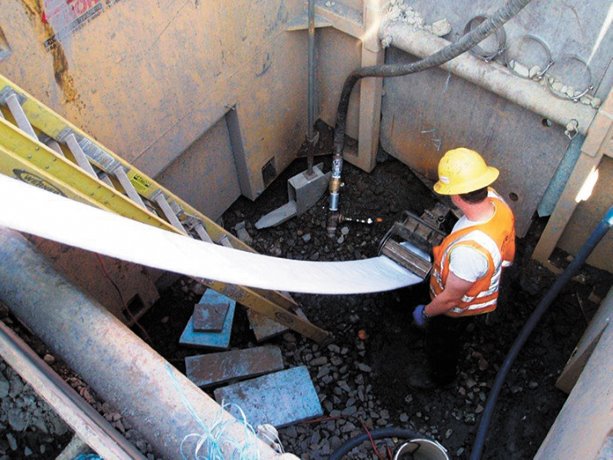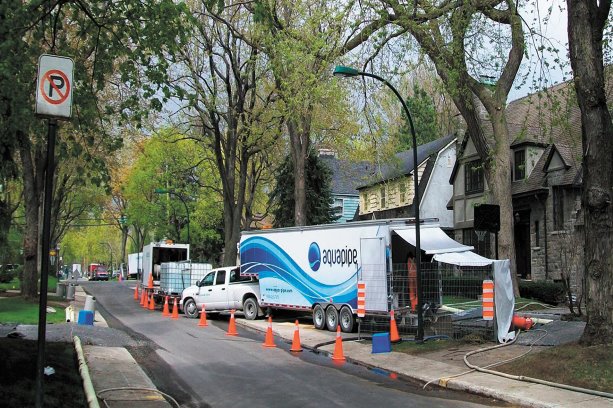The way Ben Côté sees things, it’s not so much what’s in the pipe but what’s in the pipeline.
As well he might. Côté is vice-president at Montreal-based Aqua-Pipe which makes and installs a Cured-In-Place (CIP) liner for watermains using a trenchless technology with robotic drones.
As it stands, he said, Aqua-Pipe is laying about 125 kilometres or more of liner each year but what he’s really looking at is the infrastructure across North America, which in urban areas is hitting 70, 80 even 100 years of age and is prime for failure if not repaired or replaced.
"In the U.S. especially they haven’t really started in a big way," he said, noting he expects the market to grow exponentially as age and corrosion create more demand for a trenchless solution.
CIP isn’t new technology but the materials used to create the polymer materials and the methods of deployment have advanced greatly, he said.
Aqua-Pipe burst on the scene as a pilot project with parent company Sanexen Environmental Services to demonstrate their technology in Hamilton in 2006.
It had been developed first dating back to 1999 with the National Research Council and the University of Louisiana.
The municipality was so impressed it’s been using it every since. Aqua-Pipe has similarly grown, installing liners in cities across Canada, the U.S., Australia and Europe.
"The problem with most liner systems used to be they were fine for straight runs but had an issue at each connection where you had to go back, find it and drill it out to provide service to that location," said Ian Moore, Queen’s University professor.
"Hamilton has been using this technology for the last decade now and saving millions of dollars."
There are different technologies on the market, including spray technologies. Moore’s work looks at how well that material will stand up to any shifting of cast iron pipelines and their effectiveness at the ring joints, which is where those pipes tend to fail from a combination of corrosion and soil pressure.
Moore said there are applications for CIP liners in watermain, sewer, storm culverts and even gas mains but that Aqua-Pipe has carved out a niche in the more challenging area of watermains. Also, he said, the materials used in sewer and other types of liners aren’t acceptable for drinking water.
"Sewer lines are quite large and easier to get to cut in the connections," he said.
"Watermains are much smaller and usually made of cast iron. Sanexen has developed the robotics necessary to get into the pipe and find the connections (and to open the liner at those points) which are even smaller at one inch or so."
As such, cast iron is more prone to breakage from soil pressures, he said, and the liner material has to be able to deal with that.
"Spray liners are quite brittle by comparison," he said. "We’ve also found that it’s better if the liner doesn’t adhere to the inside of the pipe."
It’s not just the savings in not having to dig up a street to access a watermain, notes Côté, it avoids traffic snarls, noise, social disruption and stress.
"Our liners create a new pipe inside the old one," said Côté. "They are thinner and made of a composite material with a structural lifecycle of 50 years but it could be more, we don’t know yet."
Digital evolution is also playing a part in making installations more effective, he added.
"In 2006 we had a success ration of about 75 per cent," he said. "Now we’re up to 95 per cent and usually that’s only because of operator error. In the future we might see it fully automated without an operator and able to operate 24/7."
He said not only are the robotic drones getting smaller and more nimble as they travel through the pipe pulling the liner into place, the cameras relaying an image back to the operator are also more sensitive and provide much better resolution, creating a real life image.
Côté said Aqua-Pipe has about 80 per cent of the market but admits it’s a small market to begin with.
"With Americans slow to get interested it has not attracted a lot of competition," he said. "We lay about 125 km a year in Canada and only about 25 km in the States. America should be 10 times that of Canada but it isn’t."
Currently Aqua-Pipe’s system handles pipes six to 12 inches in diameter with the average size around eight inches but they have distributors in Australia where the pipes are as small as two inches.
"They make most of their drinking water from desalination which is expensive so most people use rainwater for laundry and washing," he said. "The next challenges will be to increase diameter.
We’re looking now at 15 inches and then going up to 24 inches which will be the next challenge."




Recent Comments
comments for this post are closed